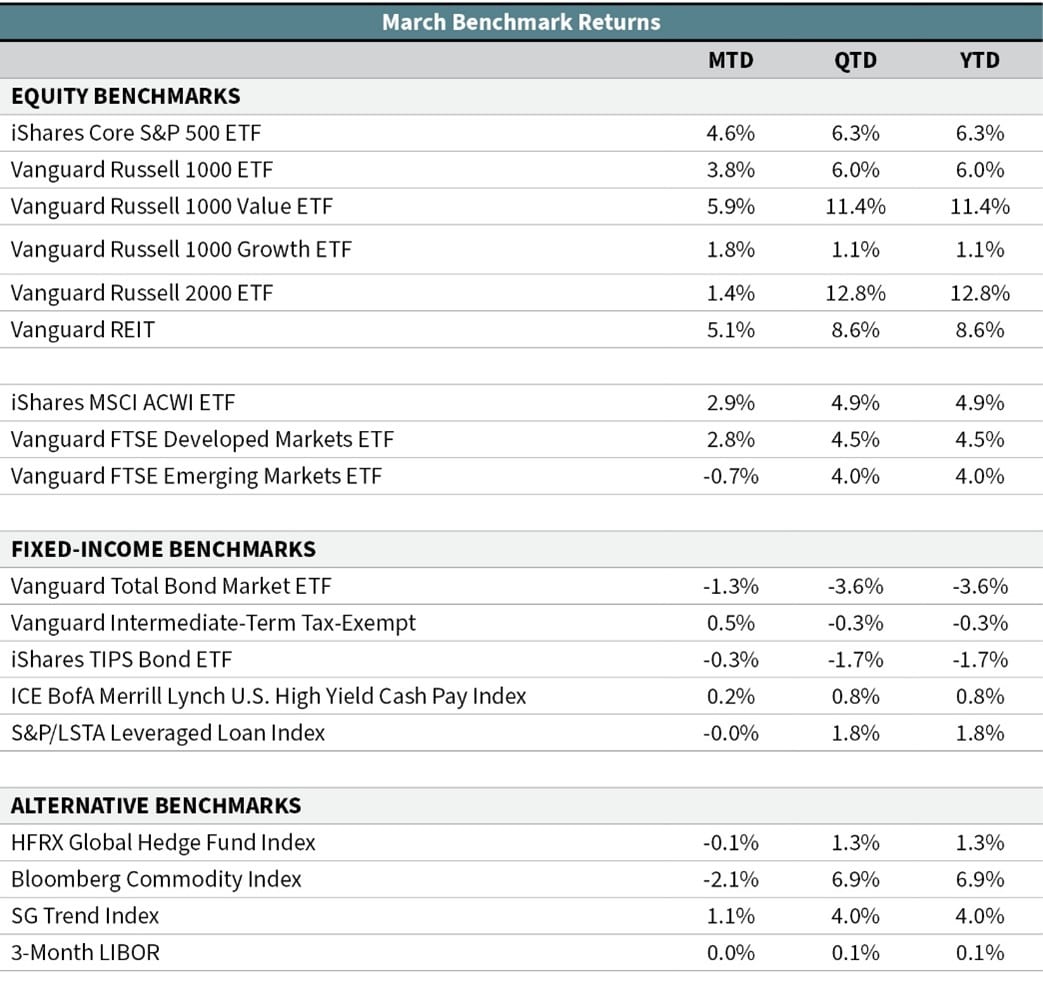Q1 2021 MARKET UPDATE
Market Recap
Global stocks continued to power upward this quarter from their pandemic bear market low on March 23, 2020. U.S. stocks developed international stocks, and emerging-market stocks are now up an astonishing 80.6%, 74.8%, and 74.6%, from the market bottom. Investors who stayed the course were rewarded for their perseverance.
Due to expectations for a reinvigorated economy this year, the market has seen a “reflation rotation”: For a couple of quarters now, equity investors have been betting on more economically sensitive small caps and value stocks and eschewing large caps and previously high-flying growth stocks.
The reflationary winds tore through the bond market as well. The prospect of higher growth and higher inflation caused interest rates to jump. The 10-year Treasury yield more than tripled from the historic low it set last August. Correspondingly, the core bond index fell 3.6%, suffering its worst quarter since 1981.
Investment Outlook
The primary variables that will determine the direction of the economy and markets remain COVID-19 developments and the fiscal/monetary policy response. These currently imply a base case for a strong economic rebound, particularly in the United States but also globally. This will support the fundamentals underpinning higher-returning asset classes—provided interest rates do not move sharply higher.
At the current vaccination rate, experts estimate the United States could achieve herd immunity by late summer. Controlling the pandemic will enable us to start getting back to normal lives, boosting economic activity. The American Rescue Plan (ARP) Act, the massive fiscal stimulus enacted early in the new administration, will supercharge economic growth further. That should in turn feed into company earnings. Yet the Federal Reserve continues to reiterate that it will not preemptively raise interest rates. It intends to wait till it sees inflation above its 2% target for an extended period, a new policy that suggests this economic cycle has plenty of room to run.
So high economic growth, strong earnings growth, but low-interest rates? Equity investors couldn’t ask for more. The main threat is valuation risk; however, stocks remain reasonably attractive relative to bonds.
Speaking of bonds, longer-term interest rates have risen in anticipation of a higher-growth, more inflationary environment. That has hurt bond investors this year. We have felt less of an impact as we reduced our exposure to core bonds, shortened duration (average maturity), and recently added inflation-protected bonds to help protect against just this occurrence. Rates could rise further in the short run leading to greater bond price declines, but they should stay contained unless inflation spikes up and stays higher …
What About Inflation?
Inflation has been at the top of investors’ list of concerns lately. Governments all over the world have passed large fiscal stimulus packages in the wake of the pandemic. There is a lot of potential pent-up spending. Add in an expected economic rebound from the pandemic, and the Fed doing everything it can to stoke a healthy level of inflation, and investors and consumers are understandably worried about maintaining their purchasing power. An inflation spiral would be bad for stocks, bonds, and pocketbooks.
In the coming months, we will almost certainly see year-over-year inflation increase, most likely to the 3%-plus range. But this is largely due to prices rebounding from the pandemic lows. We want our clients to know that what matters is meaningful, sustained inflation. The jury will still be out even after the next couple of months as to whether this higher inflation will be transitory or the beginning of a longer-term trend. Our leaning at present is that hyper-inflation should not be an imminent concern. Here’s why:
- GDP growth will sharply rebound this year, but we won’t be close to full employment for at least a few years. Wage spiral inflation can’t take hold as long as there is slack in the labor market.
- The size of the fiscal stimulus that’s been issued is staggering, but it is a one-time injection.
- Also, not all of it will be spent or spent right away. A meaningful portion will be saved and some will go to paying down debt.
- Finally, offsetting structural disinflationary forces such as demographic trends and technology adoption have not gone away or, in the latter’s case, have accelerated during the pandemic.
We have not entirely ruled out the possibility that a long-lasting shift to stimulative fiscal and monetary policies could trigger a return to an inflationary “regime” we haven’t seen since the 1970s.
This reinforces our strong belief that what has worked so well for decades, a diversified portfolio designed to withstand a variety of economic scenarios remains the most prudent approach. We expect many of the asset classes and sectors that have been laggards over the past five to 10 years to continue their rebound. Reflation favors non-U.S. stocks and more cyclically sensitive or value equity sectors. Reflation also increases the potential for rising rates and inflation, both negative for core bonds. We are already accounting for this in our portfolio positioning. Our portfolios tilt toward stocks that will benefit from higher economic growth. The fixed income portion of our portfolios has reduced sensitivity to rising rates. A portion of our long-term strategic bond exposure continues to be allocated towards alternative investments.
We thank you for your continued trust in us and invite you to reach out with any questions about your portfolio or your financial plan.
—OJM Group Investment Team


